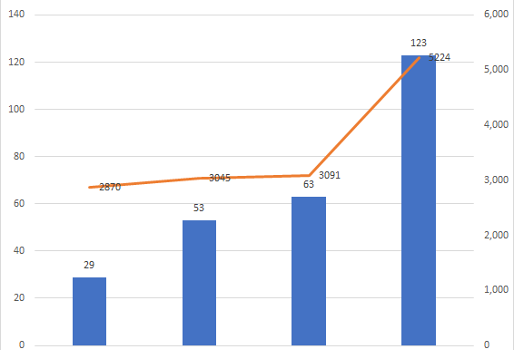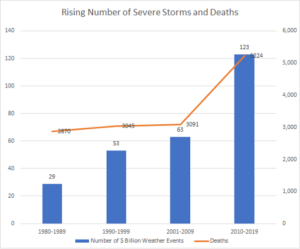
Economic Value of Estuaries Rising as Climate Change Threatens Coastal Communities
By Daniel Hayden, President & CEO
Since Restore America’s Estuaries published The Economic and Market Value of Coasts and Estuaries: What’s At Stake? in 2008 a lot has changed; providing grounds for optimism, concern, and a clear call to action.
For the most part, we have gone beyond a conversation about “if” there is climate change to one about “when” and “how much.” In a 2020 survey by the Pew Research Center, over 65% of Americans acknowledge climate change happening now, and affecting their community; the highest percentage since the survey began in 2009.
 Unfortunately, this increased public support is due in part to the devastating effects of climate change becoming more evident every day. 2020 was the sixth consecutive year in which 10 or more $1 billion+ disasters occurred, and the 10th year in a row with eight or more.
Unfortunately, this increased public support is due in part to the devastating effects of climate change becoming more evident every day. 2020 was the sixth consecutive year in which 10 or more $1 billion+ disasters occurred, and the 10th year in a row with eight or more.
The good news is that we can mitigate this by protecting our coasts. According to the Nature Conservancy, areas behind existing salt marshes have, on average, 20% fewer property damages when compared to areas where salt marshes have been lost.
From prolonged heat waves to record floods, the impacts have hit us faster than we feared. In 2017, Hurricane Harvey made landfall three times in six days. At its peak on September 1, a third of Houston was under water. Two feet of rain fell in the first 24 hours and caused $125 billion in damage. Flooding forced 39,000 people out of their homes and into shelters.
Sadly, Hurricane Harvey is not an outlier. The cost of flooding in 2019 alone was estimated to be between $15 and $29 billion. As staggering as these numbers are, they don’t even begin to count the ecological and human toll.
With increased awareness on the impacts of coastal storms and climate change, this report highlights our understanding of the role that estuaries play as natural infrastructure protecting communities and their ability to sequester carbon through natural processes called “blue carbon.” While these features were known in 2008, the economic value and science have become much clearer in the past decade.
As you’ll learn in the upcoming report, more Americans are living along coasts, increasing both the economic and human risk of coastal floods and storms. Natural infrastructure, like coastal wetlands, oyster reefs, dunes and sea grasses, all help attenuate waves, buffer storm surges and capture (and filter) flood water. They do all this while providing habitat for fish and wildlife and recreational opportunities. According to the National Institute of Building Sciences, every dollar invested in disaster mitigation leads to $6 in cost savings and a reduction in harm to people and communities.
Many reports on economic health have a contingent “if the technology were available.” However, to save our estuaries and protect our coastal communities there is no new technology required – we just need to make the decision that estuary regions, that are just 4% of our landscape but home to 40% of our people and 47% of our economy, are worth protecting and restoring.
While this report is centered on the economic value of estuaries, I hope we don’t lose sight of what is at stake if we don’t take action. As in the 2008 report, we pointed out that a focus on gross revenues and expenditures centers on activities that produce marketable goods while other activities (say birdwatching or surfing) go unquantified from an economic perspective.
Coastal areas are shared spaces for our society and therefore are not part of the traditional economic market valuation. As a result, too much attention may be given to the provision of marketed goods on the coast and too little attention given to other non-marketed, but economically, socially and culturally valuable activities.
After a successful National Estuaries Week, we should think about what we want to be as a society we should ask: what are fishing communities without fish? What are marshes without marsh grass? Will we want to continue to live along coasts if we are constantly threatened by floods and storms? I hope we can harness that spirit to create the will to make change happen and protect who, what, and where we love.
We look forward to releasing the full updated Economic Value of Estuaries Report in Fall 2021.
